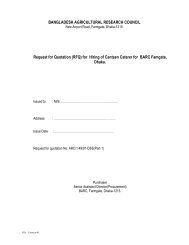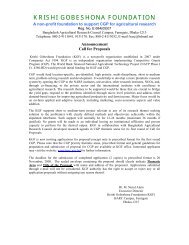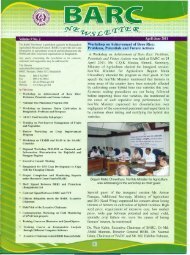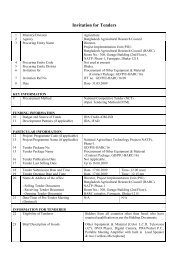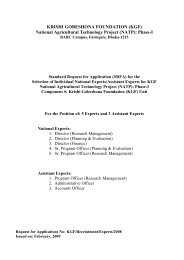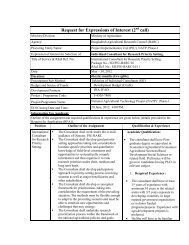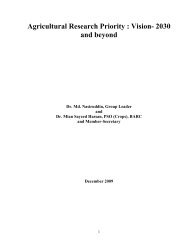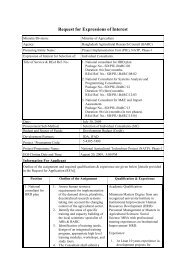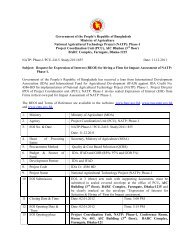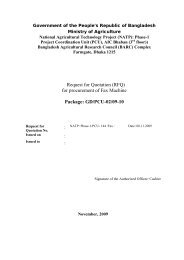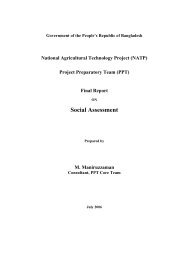ICT in Agriculture and Disaster Management - Bangladesh ...
ICT in Agriculture and Disaster Management - Bangladesh ...
ICT in Agriculture and Disaster Management - Bangladesh ...
You also want an ePaper? Increase the reach of your titles
YUMPU automatically turns print PDFs into web optimized ePapers that Google loves.
water deficit are particularly severe when drought strikes at boot<strong>in</strong>g stage. Water<br />
stress at or before panicle <strong>in</strong>itiation reduces potential spikelet number <strong>and</strong> decreases of<br />
gra<strong>in</strong>s, which results low <strong>in</strong> ga<strong>in</strong> weight <strong>and</strong> <strong>in</strong>creases empty ga<strong>in</strong>s (RRDI, 1999).<br />
Three days drought around the critical time (from 11th days to 3rd days before<br />
head<strong>in</strong>g) reduced high percentage of yield (De Datta et. al., 1975). So an estimation of<br />
water required for irrigation before plant<strong>in</strong>g is needed. For transplanted rice, seedl<strong>in</strong>gs<br />
are grown <strong>in</strong> nurseries. After transplant<strong>in</strong>g the rice crop, the l<strong>and</strong> is usually kept<br />
under submerged conditions for almost the whole grow<strong>in</strong>g period. Due to the<br />
submergence, a considerable amount of water is lost because of percolation from the<br />
rice fields. Rice crop water requirement therefore, <strong>in</strong>cludes the comb<strong>in</strong>ed effect of<br />
evapotranspiration of the crop <strong>and</strong> percolation losses, <strong>and</strong> the requirement for l<strong>and</strong><br />
preparation <strong>and</strong> nursery.<br />
Currently, 10322 kmP2P l<strong>and</strong> of the country is drought prone. The severity of flood <strong>and</strong><br />
drought is expected to <strong>in</strong>crease <strong>and</strong> also the extent. Number of days with >40 ° C<br />
would <strong>in</strong>crease to the tune of 10 to 20 days especially <strong>in</strong> the north-western <strong>and</strong> some<br />
south-western parts of the country. Aga<strong>in</strong> these parts of the country would also<br />
experience more droughts because of even lower ra<strong>in</strong>fall dur<strong>in</strong>g the Rabi <strong>and</strong> Prekharif<br />
seasons. It is likely that the Madhupur <strong>and</strong> Bar<strong>in</strong>d Tracts would be the hardest<br />
hit areas as agriculture of these areas are already constra<strong>in</strong>ed by low soil moisture<br />
conditions. The south <strong>and</strong> southeastern part of the country is affected by varied<br />
degrees of sal<strong>in</strong>ity.<br />
To cope with the anticipated climate change scenarios almost noth<strong>in</strong>g has been done<br />
by the NARS (National Agricultural Research System) <strong>in</strong>stitutes of the country.<br />
Therefore, it has become imperative to undertake research <strong>and</strong> develop mechanism to<br />
cope with the chang<strong>in</strong>g situations. Sal<strong>in</strong>ity <strong>and</strong> drought tolerant varieties need to be<br />
developed for which it is very much essential to have comprehensive underst<strong>and</strong><strong>in</strong>g<br />
of the mechanisms <strong>and</strong> pathways responsible for the impact <strong>and</strong> tolerance. In do<strong>in</strong>g so,<br />
tracer techniques <strong>and</strong> soil moisture measurement by neutron scatter<strong>in</strong>g probes could<br />
be employed.<br />
Sal<strong>in</strong>ity<br />
The country is bounded by India <strong>in</strong> the north <strong>and</strong> west, <strong>in</strong> the east by India <strong>and</strong><br />
Myanmar <strong>and</strong> <strong>in</strong> the south by the Bay of Bengal. Primarily the country is a deltaic<br />
floodpla<strong>in</strong>. Coastal area of <strong>Bangladesh</strong> lies between 20° 25’ <strong>and</strong> 23°20’ N latitude <strong>and</strong><br />
88° 25’ <strong>and</strong> 92° 24’ E longitude. The coastl<strong>in</strong>e of <strong>Bangladesh</strong> is 3,306 km fac<strong>in</strong>g the Bay<br />
of Bengal. The country has the longest beach <strong>and</strong> largest mangrove forest <strong>in</strong> the world.<br />
About 55% of the population is with<strong>in</strong> 100 km of the coast as because the country is<br />
elongated from north to south. (Table 4). More than 30% of the cultivable l<strong>and</strong> <strong>in</strong><br />
<strong>Bangladesh</strong> is <strong>in</strong> the coastal area. Out of 2.86 Mha of coastal <strong>and</strong> offshore l<strong>and</strong>s about<br />
1.056 Mha of l<strong>and</strong>s are affected by different degrees of sal<strong>in</strong>ity. Out of 151 Upazilas<br />
(sub-districts) <strong>in</strong> 19 districts coastal 93 Upazilas under 18 districts are affected by<br />
sal<strong>in</strong>ity.<br />
<strong>Bangladesh</strong> has a vast coastal area cover<strong>in</strong>g about 20 per cent of the country. As the<br />
cropp<strong>in</strong>g <strong>in</strong>tensity <strong>and</strong> crop yields are well below the country average, the<br />
contribution to agriculture sector is not proportional to its l<strong>and</strong> mass. The reason<br />
beh<strong>in</strong>d this is unfavourable agroecological conditions of the region. These <strong>in</strong>clude<br />
25





